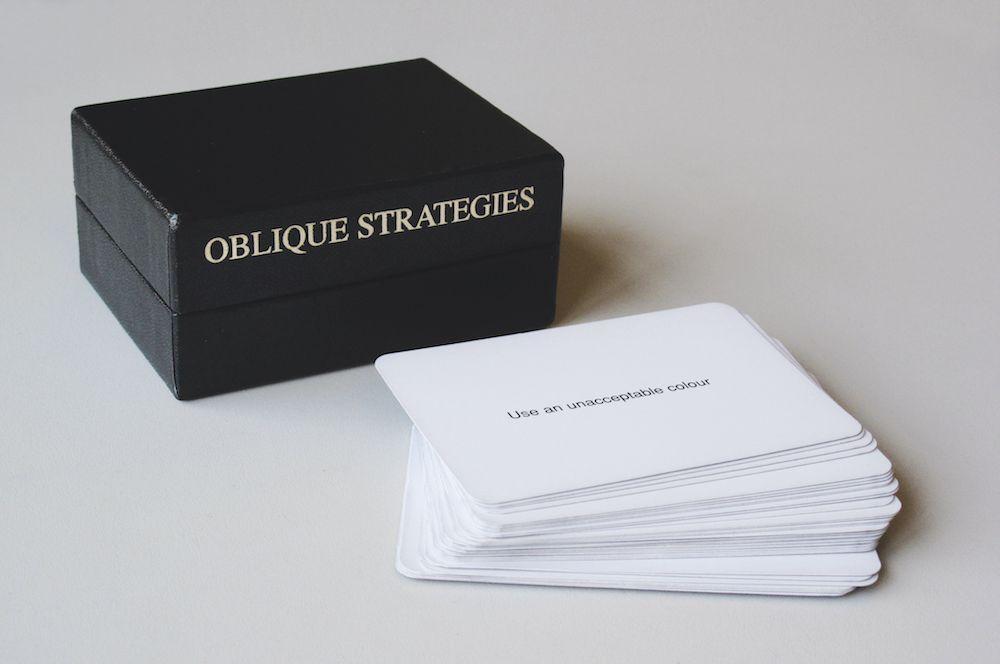This ex-rock star has solved your creative difficulties

Oblique Strategies is chaotic cure for writer's block
Creative jobs are often uncomfortable and pressurised. We feel the expectations of colleagues and clients. We fret about competitors and crazy deadlines.
Naturally, when under pressure we fall back on what has worked before. Instead of approaching creation with a sense of wonder or experimentation, the same methodology repeats itself. There’s no lateral thinking.
So indulge us while we delve into something more bohemian. In 1974, producer and ex-Roxy Music keyboardist Brian Eno worked with painter and theorist Peter Schmidt to conceive a deck of 100 small cards designed to shake you out of the creative rut. They called them Oblique Strategies and they couldn’t be more relevant today.
Musicians such as Coldplay, David Bowie, Talking Heads and the B-52s used Oblique Strategies. Eno claims chefs and even a neurosurgeon have told him they help with their work.
You pick a card at random. It will say something even more random. Anything from “(Organic) machinery” to “Cluster analysis” and “Define an area as ‘safe’ and use it as an anchor”.
The cards themselves are sometimes simple, sometimes funny, sometimes cryptic. It’s questionable whether which card you receive actually matters and they are open to interpretation. Picking one and trying to decipher what it means frees your mind and prompts you to focus on something different.
It’s a subtler version of author William S. Burroughs's “cut-up” method, where a page of text is cut up into single words or phrases and rearranged to spark new phrases and ideas. The Dadaists did it, too.
The best part of Oblique Strategies is that they’re not particularly serious either. If a card is no good, you simply pick another.

We’ve put together six content dilemmas, drawn six cards and given our interpretation:
1 You need to summarise something complex in a 40-character heading
“Allow an easement (an easement is the abandonment of a stricture)”
This hints that you should, in the first instance, ignore the 40-character limit. Double it to 80 characters then revise it downwards. Easy!
2 Your client is asking you to combine two very disparate styles. You’re unsure how to proceed
“Be less critical more often”
Give up the cynicism and try to see eye-to-eye with the client. Instead of denying it’s possible, try to come to an agreement.
3 The brief has changed completely. You have six hours to rewrite the piece
“Get your neck massaged”
Don’t work solidly for the six hours. Take 20 minutes to relax and clear your head instead of panicking.
4 You have too many client amends to handle during normal working hours
“Question the heroic approach”
Resist the urge to stay up late working on the project and treat the amends as business as usual. Above all, don’t be scared to ask for help.
5 You receive a non-brief. All the client says is “Surprise us”
“Use ‘unqualified’ people”
Step outside your bubble. Ask people in your day-to-day life what would interest them or what they’re thinking about. Seek opinions you disagree with.
6 There seems to be nothing topical to write about
“Do the washing up”
Step away from the keyboard and tidy your home or office for 15 minutes. Listen to a podcast but focus on your task. You’ll view things differently.
In the age of AI, we must cherish creative methods such as this. Today, large language models seek out the most common combination of words found across the internet. Oblique Strategies do the opposite, taking the path less travelled. Or never travelled.





